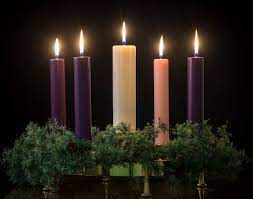
The custom of bringing evergreens into the home began in the 16th century among northern and eastern Europeans, primarily Germans, as a means of cleaning up the Christmas tree and making it more uniform. Instead of throwing out cut-off greens, people wove the excess into wreaths.
However, the religious significance is that the circular shape and evergreen material of the wreath represent eternal life. The circle, which has no beginning or end, "symbolizes the eternity of God, the immortality of the soul and the everlasting life we find in Christ."
 Advent: A Season of Active Waiting.
Advent: A Season of Active Waiting.
THE COLORS
Typically, an Advent wreath bears four tapered candles:
three purple and one pink.
A Christ candle might also be included (more later on that).
The three purple candles represent prayer, penance and preparatory sacrifice
and are meant to remind us of the character our hearts should reflect during the season:
One is pink and represents rejoicing.
Some denominations call for blue candles,
the peaceful color of the pre-dawn sky just before dawn.
Advent is that time we wait for the approaching light - Our Lord.
Tidbit: The pink candle is lit on the third Sunday of Advent,
called Gaudete Sunday.
“Gaudate" means rejoice,
and we do so because we realize that we are more than halfway through our Advent journey.
Advent, which begins the Church’s liturgical year, began on Sunday, December 3.
Advent encompasses the four Sundays and weekdays leading up to the celebration of Christmas.
The Advent season is a time of preparation for our hearts and minds for the anniversary of the Lord’s birth on Christmas.
At Mercy Home, we celebrate Advent by putting up an Advent Wreath and lighting candles each week. Our Advent Wreath is located right near the entrance of the cafeteria, and both coworkers and kids are encouraged to look at it and contemplate the meaning of Advent.
The use of the wreath and candles during Advent are a longstanding Catholic tradition
that was originally adopted by Christians in the Middle Ages as part of their spiritual preparation for Christmas.
The wreath and candles are full of symbolism tied to the Christmas season.
The wreath itself, which is made of various evergreens, signifies continuous life.
The circle of the wreath, which has no beginning or end, symbolizes the eternity of God, the immortality of the soul, and the everlasting life we find in Christ.
Even the individual evergreens that make up the wreath have their own meanings that can be adapted to our faith.
The laurel signifies victory over persecution and suffering.
The pine, holly, and yew signify immortality
and the cedar signifies strength and healing.
The pine cones that decorate the wreath symbolize life and resurrection.
The wreath as a whole is meant to remind us of both the immortality of our souls and God’s promise of everlasting life to us through Christ.
The candles also have their own special significance.
The four candles represent the four weeks of Advent, and one candle is lit each Sunday.
Three of the candles are purple because the color violet is a liturgical color that signifies a time of prayer, penance, and sacrifice.
The first candle,
which is purple, symbolizes hope.
It is sometimes called the “Prophecy Candle” in remembrance of the prophets, especially Isaiah, who foretold the birth of Christ. It represents the expectation felt in anticipation of the coming Messiah.
The second candle,
also purple, represents faith.
It is called the “Bethlehem Candle” as a reminder of Mary and Joseph’s journey to Bethlehem.
The third candle is pink
and symbolizes joy.
It is called the “Shepard’s Candle,” and is pink because rose is a liturgical color for joy. The third Sunday of Advent is Gaudete Sunday and is meant to remind us of the joy that the world experienced at the birth of Jesus, as well as the joy that the faithful have reached the midpoint of Advent.
On the fourth week of Advent,
we light the final purple candle
to mark the final week of prayer and penance as we wait for the birth of our Savior. This final candle, the “Angel’s Candle,” symbolizes peace. It reminds us of the message of the angels: “Peace on Earth, Good Will Toward Men.”
Though the Mercy Home Advent wreath does not include a white candle, this is a tradition that has become popular in modern day adaptations.
The white candle
is placed in the middle of the wreath and lit on Christmas Eve. This candle is called the “Christ Candle” and represents the life of Christ. The color white is for purity—because Christ is our sinless, pure Savior.
Read more Trivia.